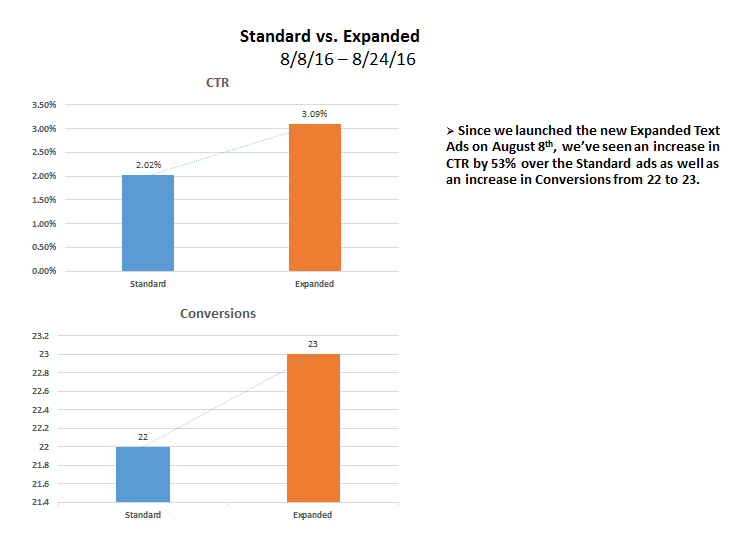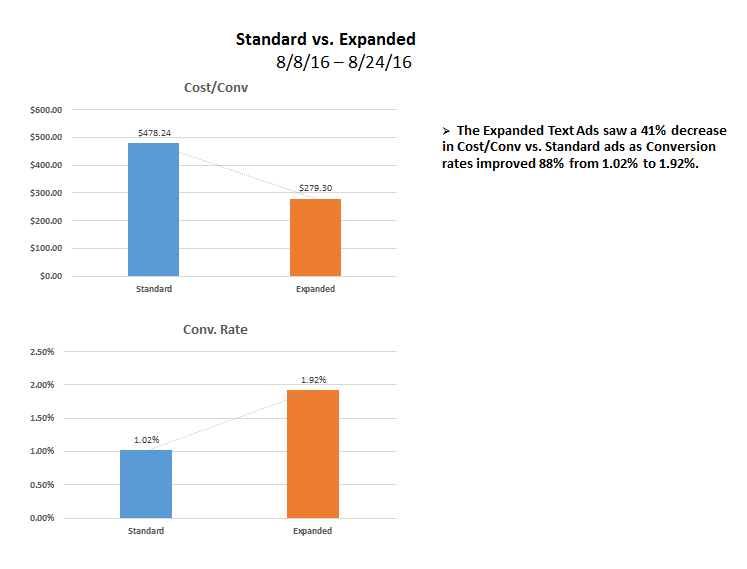In May of this past year, Google announced what they are calling the biggest change to text ads since AdWords, which launched 15 years ago. Soon-to-be-gone are the days of the tried and true 25-35-35 character limits of current standard ads, and here is the future: extended text ads (ETAs) catering towards AdWord’s “mobile first” world. What exactly do these extended text ads mean for agencies and their clients?
The new extended text ads will be available for both search and display campaigns and will feature two new headline fields at 30 characters each, replacing the old 25 character headline. In lieu of the 2, 35 character description boxes, there will now be one, long description field with an 80 character limit. The new 140-character extended ads are designed to stand out among mobile search results and maximize ad performance. As more and more searches are done on these devices, we will now have more opportunity than ever to engage users within the first click. Below is a comparison of the old standard ads and the new extended ones, on both desktop and mobile.

What is the opportunity for AdWords Marketers with expanded text ads?
Along with the sheer amount of clickable space doubling, advertisers can now make every extra character count, extending their clients’ emotion-evoking stories, descriptive product features, and compelling promotions. No longer will advertisers feel that they have to exclude important information in their descriptions. Google has offered advertisers the perfect chance to reinvent their messaging in search, not just add meaningless text to fill space. Advertisers will now be able to utilize ads even more to their advantage and target potential customers more accurately than ever. ETAs provide additional opportunities for advertisers to connect with users and drive more qualified leads.
Does character limit really affect clicks?
Charles River Interactive (CRI) has already started rolling out ETAs amongst clients, and the results are very promising. Within a month of running the new ETA’s for one client, CRI found that click-through-rate (CTR) for the expanded ads was 53% higher than that of the remaining standard ads. With the same client, CRI analyzed that conversions also increased and the average cost per conversion for expanded ads was 41% lower than that of standard ads. Other early reports indicate that ETA’s increase CTR by 20% on average. So, from what we can tell, the expanded ads are having a positive effect all around for advertisers.


What other changes are being made?
Along with expanded descriptions and headlines, expanded text ads in AdWords will also now automatically pull the display URL from the final URL. Advertisers will then be able to add up to two optional paths to boost the display URL, both of which can be up to 15 characters long. These paths offer another opportunity for strategizing which allow advertisers to add short terms to describe to users what they will find on their landing page, and show them that it’s exactly what they were looking for, enticing them to click even more.

When will ETA go into effect?
Previously, Google had announced that all ads had to be switched from standard to expanded format by the end of October, but this past week, this deadline was pushed back a few more months to January 31, 2017. While this may seem like a while away, this extra time shouldn’t be ignored, and it’s smart to get a head start before advertisers and clients are rushed to write and approve all new copy. This additional extension also gives agencies, advertisers and clients extra time to strategize on how they want to implement these changes. Have clients been able to say what they want in their ads, or do they get cut off? It’s important that all advertisers consider how this may affect their brand – and how they want to use the new characters to tell more about their brand story and products.
Interested in learning more about marketing trends? Check out Charles River Interactive’s blog View from the Charles:
Mobile First Strategy: What You Need to Know
How to Write Strategic Calls to Action
